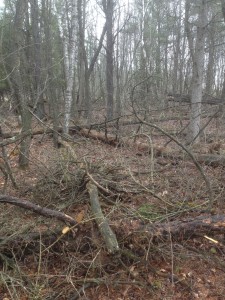
We live in an imperfect world. Or rather, what we see as imperfection is actually the way things should be sometimes.
A forest is a complicated place. There are hundreds, or thousands, or if you include the soil hundreds of thousands of species of living things there- growing, reproducing, dying, decomposing, recycling. There is more going on than we can comprehend.
In a few weeks Woodland Dunes will be hosting a free workshop for landowners titled “My Healthy Wetland”, which will be presented by the Wisconsin Wetlands Association, and Lakeshore Natural Resource Partnership. A group of us who are planning the day which includes a visit to wetlands in our preserve, was looking at the forest around one of our swales, and noting the presence of dead trees which provide nesting places for many birds, including the wood ducks which were present during our visit.
Common perception does not identify dead trees as an attractive feature. Or downed wood after they fall. The forest floor at Woodland Dunes is littered with trunks and branches, and at first glance it looks like a mess. We are frequently asked why we don’t “clean up” the woods, and use the downed wood for firewood or something so that it doesn’t go to “waste”. We equate the best use for something in terms of how it benefits us, not the larger natural world, but that’s a very questionable proposition.
Ecologically, I think people are very important as a species because we have a tremendous ability to disrupt nature. Most of that is unintentional, of course, but it is amazing the damage we can do because we don’t understand. In terms of healthy functioning of a forest, the organisms in the soil, including bacteria and fungi, are very important to it’s well being. As more and more research is conducted, this becomes more apparent. Downed wood is very important for it’s role in feeding soil organisms, which in turn help plants grow and even communicate with one another, which sounds like science fiction. Downed wood provides shelter for many animals of all sorts, and the structure it provides makes habitat suitable for others- like a number of birds. Ruffed grouse, ovenbirds, wood thrushes, winter wrens, and others prefer the kind of forest structure that downed wood provides.
And then there are insects, which may be the most important animals of all. Recently a lot of alarm has been raised about the decline of pollinating insects whose importance is easy to understand. But on a larger scale, insects are like living pipelines that carry bits of solar energy gathered by the plants they feed on, and distribute it throughout their world as they are eaten by other animals. Many of them depend on woody material in their habitat for food or shelter, or a place to reproduce.
And then there’s carbon. Trees capture carbon from the air and use it to make wood. Burning that wood releases carbon back into the air. Right now, there appears to be too much carbon in our atmosphere, so removing it from the air keeping it locked up in wood or soil for as long as possible is probably a very good thing.
So if you own a woodlot, don’t feel that dead or downed trees are being wasted. In fact, they enrich the forest in ways we still barely understand, and leaving at least some of them, even though it looks messy, might be one of the best things you can do for the health of the woods.
